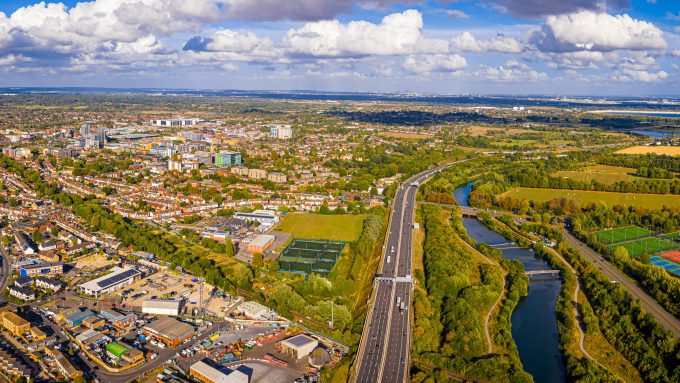
Connected Places Catapult and KPF apply the power of data to masterplanning, to achieve the cities of the future

Connected Places Catapult (formerly Future Cities Catapult) partnered with Kohn Pedersen Fox Associates (KPF) to look at how emerging data-focussed technologies could deliver masterplans for the 21st-century city.
Cities are growing at an incredible rate. Currently, 55% of the world’s population lives in urban areas and the United Nations projects that 68% of the global population will be living in cities by 2050. With this influx of people, designers and planning authorities are continually challenged with creating successful urban environments, creating places where people want to live and work, increasing housing supply and providing infrastructure. As the pace of change accelerates, Connected Places Catapult and KPF are looking at what the future holds for masterplanning; how emerging data-driven technologies will positively disrupt traditional practice to help us deliver faster, more agile, future-proofed masterplans to meet the needs of the 21-century city.
The result of their collaboration is the design of a hypothetical digital tool with three major innovations:
Firstly, aggregate data needed to understand site context by drawing from public and private sector organisations by plugging into their existing application programming interfaces (APIs). In the Uk, this could provide mapping data from Ordnance Survey; planning policy from the local planning authorities; traffic counts from historic surveys; cultural and historical assets, as designated by local people; or existing movement patterns from mobile phone data. This would replace time-consuming, piecemeal research required to gather and map out contextual data.
Secondly, using third-party algorithms to undertake analysis and test impact. These algorithms would be provided by specialist consultants, for analysis of topics such as transport, daylight and wind testing. Others might be open source, provided by public authorities analysing open space deficiency or housing need.
Finally, a live data-rich precedent library, much like the library of building components you get in many BIM and 3D software tools, but with up-to-date data from existing built developments across the world. This would include data on occupancy, energy use and sales values, as well as floor plans and construction costs.
These innovations would radically change the amount of time spent gathering and analysing data, allowing designers to quickly iterate and test design options. Data from the precedent library could be combined with real-time data from the surrounding context, automatically calculating the impact of selected building options on traffic, open space and social infrastructure. This could be used to compare against policy in real-time, highlighting key issues.
The result wouldn’t be a finished masterplan, but a robust understanding of the impact that different development scenarios would have, allowing architects, developers and local authorities to be better informed about the changing relationship between their proposals and the local neighbourhood.
Cobus Bothma, Director of Applied Research, Kohn Pedersen Fox Associates, said: “We see this as a tool to augment the traditional skills of the architect. This would radically change the way that architects and master planners practice, allowing them to spend less time gathering all the relevant information for site analysis and freeing up more time for creative work. We’re already using some of these techniques to help clients optimise their sites.”
Euan Mills, Head of Digital Planning, Connected Places Catapult, said: “Some of this might feel farfetched. It relies on innovations in how data is provided from the public sector and new business models from the private sector. Disruption is inevitable which will make masterplanning more robust and responsive.”
For further information, contact Dean Samways, PR & Social Media Officer at Connected Places Catapult
E: dean.samways@cp.catapult.org.uk
T: 07834 287246
Note to editors:
The Future of Masterplanning, with Connected Places Catapult and Kohn Pedersen Fox Associates
June 13 2019
09:00-10:00
One Sekforde St., London, EC1R 0BE
Connected Places Catapult
Accelerating smarter living and travelling in and between the places of tomorrow, Connected Places Catapult focuses on growing businesses with innovations in mobility services and the built environment that enable new levels of physical, digital and social connectedness. Connected Places Catapult operates at the intersection between public and private sectors and between local government and transport authorities, convening the disparate parts of the market, helping innovators navigate the complexity of doing business, creating new commercial opportunities and improving productivity, socio-economic and environmental benefits for places.
Connected Places Catapult’s Future of Planning program explores how digital innovation, urban data and user-centered design can improve urban planning by de-risking and proving the demand for data-driven and digitally-enabled products and services required to create a planning system fit for the 21st century.
Kohn Pedersen Fox Associates
Kohn Pedersen Fox Associates is an internationally recognised design firm, providing masterplanning, architecture and interiors for clients in both the public and private sectors. Operating as a unified practice with offices in Berlin, London, New York, Asia, and the Middle East, KPF is led by 30 Principals and has over 650 staff members.
With experience designing some of the world’s most complex, large-scale spaces, KPF understands the importance of master planning in the process of creating or re-imagining a site.
Whether for a single block, a business district, or an entire city, we seek to provide a prudent and cognisant framework for future growth. Our approach to masterplanning is similar to the approach we take on smaller-scale architectural projects—emphasising the importance of long-term flexibility, function, and resiliency. Our designers also take great care to understand the nuances of place, developing plans that take into account local and regional issues, ranging from public health concerns to social conventions.
We have developed master plans for projects all around the world in a variety of settings, from the historic fabric of London’s Covent Garden to outmoded office parks in suburban New Jersey and the ‘smart’ New Songdo City in Incheon, Korea. (https://www.kpf.com/)





